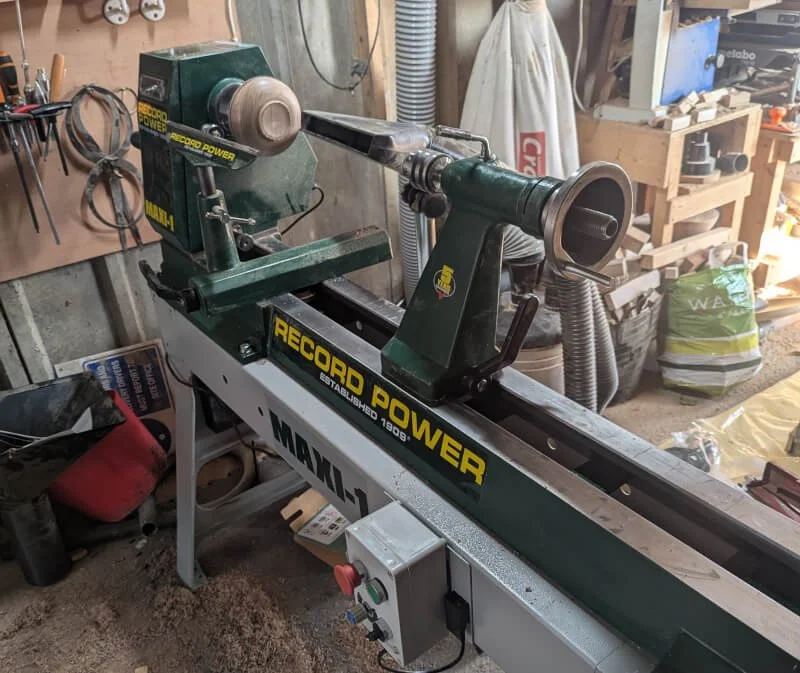Record Power Maxi-1 vs Record Power Envoy: Which Woodturning Lathe is Best?
Last year, I decided it was time to upgrade from my Axminster Hobby Lathe.
The Axminster Workshop AW305WL was my first lathe - bought back in 2020. It served me well, but as my woodturning projects got more ambitious, I found myself pushing its limits.
After saving up for a while, I finally had enough to go for a serious upgrade.
I knew I wanted something robust—something that could handle large bowls, deep hollowing, and long spindles without struggling.
After doing plenty of research, I narrowed my choices down to Record Power.
They’ve got a strong reputation, and I liked the idea of investing in a lathe that could last me for years.
At the time, I compared two of their top machines.
The Record Power Maxi-1:
Image credit: Record Power
And the Record Power Envoy:
Image credit: Record Power
I went deep into the details, weighing up capacity, power, footprint, and versatility before making my decision.
Now, after using my new lathe for several months, I thought I’d share my findings for anyone else considering an upgrade.
Lathe Size & Blank Capacity
One of the biggest factors in my decision was capacity. I wanted a lathe that could handle large bowls as well as long spindle work - for me, that is mainly wooden vases.
The Maxi-1 has a maximum between centres capacity of 950mm, giving me plenty of room for long spindle turning.
The Envoy has a working distance of 610mm, though you can extend this with an optional bed extension.
For wooden bowls:
The Maxi-1 has a 533mm swing over the bed and a 762mm maximum bowl diameter, meaning it can handle much larger pieces.
The Envoy has a 410mm swing over the bed, but interestingly, it has a maximum bowl diameter of 1000mm with the right setup.
While the Envoy’s bowl diameter figure is impressive, in practical use, the Maxi-1’s larger swing and overall capacity made more sense for the kind of work I do.
Power & Variable Speed Control
A lathe’s power can make or break the experience, especially when roughing out large, heavy blanks.
The Maxi-1 comes with a 1.5hp motor and a speed range of 50-3850rpm. That low starting speed (50rpm) is a major advantage for safely roughing out big, unbalanced blanks.
The Envoy has a 1.5kW input / 1.1kW output motor, meaning it provides solid performance but slightly less continuous power. Its speed range is 100-3800rpm, which is better than I originally thought but still doesn’t quite match the Maxi-1 for ultra-slow roughing speeds.
Both lathes also come with variable speed control. Which is a very useful thing.
I wanted a lathe that could handle anything without struggling, and the Maxi-1’s lower speed range was a huge advantage for safely working with large pieces.
Weight & Stability
A heavier lathe reduces vibration. Making it smoother and safer—especially when turning large, out-of-balance blanks.
The Maxi-1 weighs 231kg—as much as a fully loaded fridge or a small upright piano.
The Envoy weighs 140kg, making it noticeably lighter.
More weight = more stability. The Maxi-1’s extra mass meant I wouldn’t have to worry about it shifting or vibrating under load.
Footprint & Workshop Space
I don’t have endless space in my workshop, so I needed to make sure my new lathe would fit.
The Maxi-1 takes up 1640mm x 545mm (0.89m² of floor space).
The Envoy takes up 1435mm x 540mm (0.77m² of floor space).
While the Maxi-1 is larger, I was willing to make space for it since the trade-off was much greater turning capacity.
Features & Accessories
Both lathes come with M33 x 3.5 spindle threads and MT2 tapers, making them compatible with most accessories.
However, the Envoy offers a few extra built-in features:
Self-ejecting tailstock
Ram travel scale (for precise depth measurement)
Optional extras, including a bowl-turning attachment and bed extension
I didn’t mind missing out on the Envoy’s extra features, since my focus was on getting the best raw performance.
Swivel Headstock
Both the Maxi-1 and Envoy come with a swivel headstock, which is a great feature for bowl turning.
A swivelling headstock allows you to rotate the headstock to different angles, giving you better tool access and reducing the need to lean over the lathe bed—making turning larger bowls more comfortable.
Maxi-1 Swivel Headstock: The headstock can be rotated for better access when turning larger pieces, and when combined with an outrigger, it allows for even greater flexibility.
Envoy Swivel Headstock: The headstock also swivels, making it easier to position work at a more comfortable angle for hollowing bowls and larger turnings.
Since both lathes offer a swivel headstock, this feature wasn’t a deciding factor.
However, it’s a valuable addition on both machines, making bowl turning much more ergonomic and user-friendly.
Lathe Comparison: Maxi-1 vs Envoy Specs
| Feature | Record Power Maxi-1 | Record Power Envoy |
|---|---|---|
| Between Centres Capacity | 950mm | 610mm (extendable) |
| Swing Over Bed | 533mm | 410mm |
| Maximum Bowl Diameter | 762mm | 1000mm |
| Speed Range | 50-3850rpm | 100-3800rpm |
| Motor Power | 1.5hp / 1.6kW input / 1.1kW output | 1.5kW input / 1.1kW output |
| Weight | 231kg | 140kg |
| Footprint | 1640 × 545mm (0.89m²) | 1435 × 540mm (0.77m²) |
| Spindle Thread | M33 x 3.5 | M33 x 3.5 |
| Taper | 2MT (Morse Taper 2) | 2MT (Morse Taper 2) |
Which Lathe Did I Choose?
After weighing up all the specs and what I needed from a lathe, I went with the Record Power Maxi-1—and I couldn’t be happier with my choice.
It is a bit older as a model and doesn’t come with a RPM display, which most modern lathes seem to as standard now. But a lot of that seems like a luxury that I was willing to do without.
Since setting it up in my workshop, it has handled everything I’ve thrown at it without complaint.
First test bowl (small) on the new lathe last year
Whether I’m roughing out a heavy blank or turning longer spindles, it performs beautifully.
I didn’t opt for the outrigger at the time of purchase. That is something I will look into if and when I need to turn blanks larger than the swing over the bed can accommodate.
The extra weight keeps it rock solid (it was extremely hard to build and get into place!), and I’ve yet to push it to its limits.
If you’re considering one of these two lathes, I hope this breakdown helps.
Both are fantastic machines, but if you want raw power, stability, and a bigger turning capacity, I’d highly recommend the Maxi-1.



